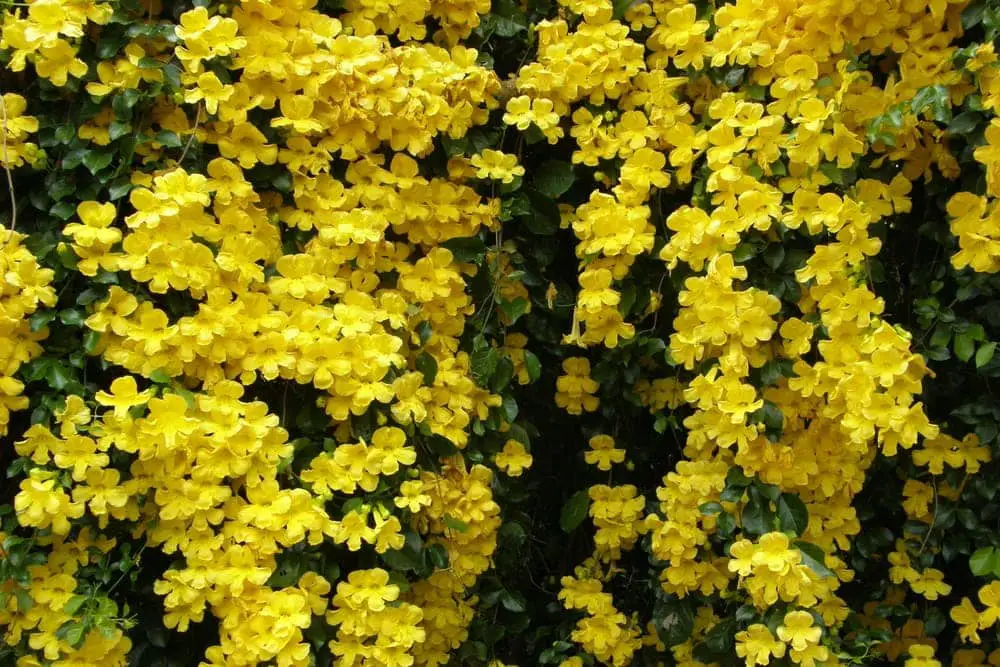So named after the distinctive claw-like tendrils on its vine, cat’s claw plants are prolific, showy, and fragrant additions to the garden.
In warmer zones, this is a highly invasive species that can cause damage to native plants. In cooler zones and deserts, it can be raised as a vigorous easy-care drought-resistant annual that will gladly crawl along fences, poles, and even buildings. Fragrant yellow trumpet-shaped flowers attract bees and butterflies.
Cat’s Claw Plant Care and Growing Guide
1. Light and Water
Cat’s claw plants prefer full sun and will tolerate part shade. The vining habit of this plant allows it to travel to an area with more sun if planted in shadier areas. It is drought resistant and requires very little watering. Occasional watering is enough for this sturdy vine.
2. Soil
Best planted in restricted spots like between a wall and concrete pavement, cat’s claw vines are easy to grow in almost any type of soil. This woody vine prefers well-drained soil and will tolerate desert climates with infrequent watering. Unlike more delicate plants, cat’s claw grows best in poor soil, sandy soil, or clay.
3. Climate
Cat’s claw vines are hardy evergreens in zones 8-11, but this plant is considered an invasive species in the southern United States and is not recommended for planting. In cooler zones, cat’s claw can be planted as an annual. It will tolerate temperatures down to 10 degrees fahrenheit.
In desert climates, deeply water cat’s claw once per month. In especially hot desert areas, the plant may need more frequent watering to prevent burning on the leaves. If necessary, fertilize in late winter with a 10-10-10 balanced fertilizer. Cat’s claw vines are an extremely popular plant in hot and dry zones.
4. Propagation
A highly enthusiastic plant, cat’s claw vines can be propagated in a number of ways. Most commonly, their lightweight seeds will take flight and self-sow in any type of soil. They can also be propagated from cuttings with minimal effort.
Cat’s claw plants have tubers that can be used to grow new plants, as well. After planting, maintain moist soil until the plant is well-established, watering two to three times per week. It is ready to be transplanted after only a few weeks. It will need very little watering thereafter except in very dry climates.

5. Flowers and Leaves
Cat’s claw vines are excellent for creating a natural screen. They are perfect for disguising unsightly walls, fences, or poles. The lush green vines explode into a profusion of bright yellow flowers in the springtime. Cut back the vine after flowering to encourage another bloom. Each flower trumpet-shaped flower is three to four inches in diameter and has a strong fragrance.
The flowers are attractive to bees, butterflies, birds, and other pollinators. This makes them highly beneficial for nearby gardens and other plants, so long as they are planted at such a distance that they will not interfere with their growth.
6. Vining Habits
Cat’s claw vines are well known for the distinctive three claw-like prongs on its tendrils. These claws are highly effective at allowing the vines to climb up to a tremendous size. The woody vines can grow up to 20-30 feet or as long as it has something to claw onto. It has even been known to cling to glass.
Cat’s claw plants are perfect for trellises, poles, or the sides of buildings. The vines can climb vertically or crawl along the ground. Avoid planting the vine near native plants and trees. It will require frequent and aggressive pruning to control the vine. It will look bushy and unkempt if not pruned regularly. Use cat’s claw plants as a natural screen or for erosion control.
7. Pruning
Once established in hardy zones, cat’s claw can be very difficult to eradicate. Avoid planting cat’s claw in zones where it is considered invasive. Once established, the plant can be controlled by pruning.
Remove all suckers and offshoots to prevent the plant from becoming leggy. Prune just after flowering to encourage more blooms. Cut the plant all the way to the ground to regrow a smaller, more manageable vine. It will readily regrow after even the heaviest pruning. Frequent trimming and pruning will maintain the vine on a trellis, fence, or wall.
It is not recommended to allow this vine to grow on trees as it will quickly overtake the tree and cause damage. Avoid planting cat’s claw near flowerbeds, native plants, or anything you would not like it to overtake. When allowed to grow vertically, this vine is an attractive and showy addition to the garden.
If cat’s claw vines creep along the ground, they will quickly form a thick mat and smother plants on the ground. Careful training, pruning, and trimming will keep this beautiful and fragrant vine in check.
8. Plant Uses
Cat’s claw plant is used in traditional medicine for a wide range of purposes ranging from treating acne to arthritis.
Invasive Species Warning
Cat’s claw vines, also known as cat’s claw creepers or yellow trumpet vines, are considered an invasive species in the southern United States from zone 8 through 11. As an invasive species, it is extraordinarily difficult to remove and can cause extensive damage to native plants as well as buildings. It is especially damaging in urban areas, but will also cover and shade native plants. It is especially damaging in rainforest climates or near water sources. This plant is not recommended to be planted in zones 8-11.
Common Problems
Cat’s claw is an incredibly hardy plant with no known diseases or pest problems.
Keep reading: Watermelon Peperomia Care & Growing Guide
Conclusion
Cat’s claw plants are incredibly fast-growing vines that will eagerly provide a natural screen, erosion control, and a splash of color. This plant is easy to grow in almost any climate. In warm moist climates, they are considered invasive species but are beautiful additions to gardens in desert zones.
In temperate zones, the vine is an annual. Cat’s claw plants thrive with full sun and little water and reward the grower with a burst of yellow flowers that attract pollinators.
Also read:
Victoria is the owner and main author of hobby plants. She loves spending her free time in her garden planting and taking care of her plants. Victoria hopes you enjoy the content here!





![Mother Of Thousands Plant [Complete Plant Care Guide] Mother Of Thousands Plant [Complete Plant Care Guide]](https://www.hobbyplants.com/wp-content/uploads/2022/07/mother-of-thousands-plant-300x158.jpg)
![Majesty Palm Plant Care: [Complete Beginner's Guide] Majesty Palm Plant Care: [Complete Beginner's Guide]](https://www.hobbyplants.com/wp-content/uploads/2022/08/majesty-palm-care-300x158.jpg)
![Exotic Angel Plant Care: [Complete Beginner's Guide] Exotic Angel Plant Care: [Complete Beginner's Guide]](https://www.hobbyplants.com/wp-content/uploads/2022/08/exotic-angel-plant-care-300x158.jpg)
![Snow White Waffle Plant: [Complete Care Guide] Snow White Waffle Plant: [Complete Care Guide]](https://www.hobbyplants.com/wp-content/uploads/2022/08/snow-white-waffle-plant-300x158.jpg)
![Waffle Plant Care: [Complete Beginner's Guide] Waffle Plant Care: [Complete Beginner's Guide]](https://www.hobbyplants.com/wp-content/uploads/2022/08/waffle-plant-300x158.jpg)
![Bird Of Paradise Plant Care: [Complete Beginner's Guide] Bird Of Paradise Plant Care: [Complete Beginner's Guide]](https://www.hobbyplants.com/wp-content/uploads/2022/08/bird-of-paradise-plant-300x158.jpg)
![Purple Passion Plant Care: [Complete Beginner's Guide] Purple Passion Plant Care: [Complete Beginner's Guide]](https://www.hobbyplants.com/wp-content/uploads/2022/08/purple-passion-plant-care-300x158.jpg)